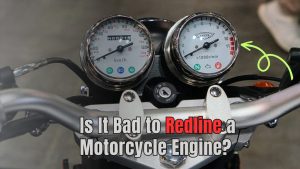It’s annoying and worrisome when you’re out riding and your motorcycle engine keeps cutting out.
We’ll discuss some of the most common causes of intermittent cut-outs and what you can do when it happens.
Possible Causes of Motorcycle Engine Keeps Cutting Out
One thing we’ve learned from our years wrenching on bikes is there’s usually a reason these cut-outs occur.
Nothing frustrates riders more than a bike that was fine one minute and dead the next with no explanation.
Now let’s dive into some potential causes so you’ve got an idea where to start looking when the bike starts acting up.
1. Fuel Supply Issues
Let’s talk fuel supply issues. Running dry in the petcock or a clogged line are common culprits when a bike decides to quit. The common issues you can face are:
- Low fuel
- Clogged fuel line or filter
- Contaminated fuel
- Faulty fuel pump
We’ve all been there – riding along one minute, then boom, she’s dead.
We’ve coasted into more than one gas station on fumes before realizing it was time for a fill up. But sometimes even a full tank ain’t enough if something’s blocking the flow.
Clogged filters are probably the number one common problem. Nothing will make a bike shut off faster than when the fuel ain’t getting where it needs to go.
Dirt or debris in the line or filter just takes one tiny piece to cut off fuel to the engine. Been there before where pulling the filter revealed it was more gunk than gas flowing through!
Contaminated fuel will mess things up too. Get some water or debris mixed in and it’s bye-bye time. Always store bikes with full tanks and some fuel stabilizer added.
And don’t be like my buddy who tried using diesel “cause it was cheaper!” Some lessons you only learn the hard way.
SEE MORE: Motorcycle Carb Leaking Gas: Reasons and Fixes
Even a good old fashioned fuel pump can fail. The amount of work just to find a 25-dollar part is enough to make you question why you ever started wrenching.
But better to find these issues before they really leave you stranded.
So, always ride with plenty of fuel, keep your tank and lines clean, and consider carrying some extra gas just in case.
FIXES: Fuel supply fixes include replacing dirty filters, fuel pumps or cracked rubber lines. Tightening loose clamps or installing an inline primer bulb can help as well.
2. Ignition Issues
When a motorcycle engine cuts out intermittently, ignition issues can often be to blame. Some of the problems are:
- Faulty spark plugs
- Damaged ignition wires
- Bad ignition switch or coil
Spark plugs don’t last forever, and over time they become worn or fouled. This prevents them from firing properly.
It’s recommended to replace plugs every few years or 10,000 miles as maintenance. But if one goes bad early, it can cause intermittent cutting out.
Ignition wires carry the spark from the coil to each plug. Over many heat cycles, wiring can crack or insulation can break down.
This interrupts the spark signal. Wires are inexpensive to replace and it’s a good idea to swap them any time plugs are changed.
The ignition switch and coil initiate the spark. Switches may develop faulty contacts after years of use. Coils can also fail internally.
Problems here would result in complete no-starts or intermittent cutting out that’s tough to pin down. Replacing these components may be necessary if other ignition sources check out fine.
It’s not uncommon for issues like rough idling or backfiring to precede a more serious ignition problem behind intermittent cut-outs.
Pay attention to any changes in performance. And routine maintenance like inspecting plugs and wires during regular services can catch small problems before they worsen.
FIXES: For ignition trouble, swapping out faulty spark plugs, plug wires or ignition components gets you firing on all cylinders again.
3. Air Supply Issues
Some air supply issues can also lead to frustrating intermittent engine cutting outs.
A clogged air filter is a main culprit, preventing the engine from receiving enough oxygen.
Filters should be cleaned or replaced regularly based on your owner’s manual schedule. Neglecting this simple maintenance task can wreak havoc on engine performance.
Intake boots and manifolds route filtered air from the filter box to the engine. Over time, rubber boots can develop cracks or splits that cause tiny air leaks.
Likewise, manifold joints may loosen due to vibration. Small leaks slowly reduce air volume, resulting in fluctuating idling or stalling issues.
Tightening clamps and inspecting boots for cracks during routine services can catch minor problems before they worsen.
For riders who modify their bikes, ensuring custom parts don’t impede airflow is critical. Replacement air boxes must permit the same air volume as stock to avoid stranding riders.
Intake changes may require retuning of the fuel injection if oxygen levels alter combustion.
While air supply issues may be less frequent causes of intermittent cut outs than fuel or ignition concerns, it pays to check this system too.
A small air leak unnoticed during inspection could lead to bigger frustrations down the road.
Clean filters and tight boots go a long way towards keeping bikes running smoothly mile after mile.
FIXES: Air supply fixes involve cleaning or replacing dirty air filters. Apply sealant or tighten clamps on cracked intake boots too.
4. Engine Issues
Problems within the engine itself can also lead to frustrating intermittent cut outs. As bikes rack up mileage, normal wear occurs. Some common issues are:
- Worn valve components
- Low compression3
- Damaged injectors
Valve components like tappets, lifters and guides need regular adjustment to compensate for clearance wear.
Ignoring scheduled maintenance allows slack to develop, disrupting valve operation and fuel/air delivery. This can cause hard starting, stumbling or stalling at idle.
Over time, cylinder walls wear tiny amounts each engine cycle. Low compression prevents proper combustion, and intermittent symptoms may show.
A compression test4 helps identify if rebuilding is needed.
Fuel injected bikes rely on healthy injectors to precisely meter fuel. Clogged or stuck openings disrupt fuel/air mixing.
Backfiring, stalling and other strange behaviors can point to injector problems.
While engine issues may be costlier to repair, catching small problems during regular tune-ups saves headaches down the road.
SEE MORE: Engine Heat 101: How Hot Does a Motorcycle Engine Get?
Things like lash adjustment, new gaskets and spark plugs are inexpensive maintenance tasks motorcycle owners can do themselves.
This helps prevent expensive repairs and keeps trusted steeds safely on the road.
FIXES: Common engine repairs consist of basic maintenance like adjusting valve lash or changing worn gaskets. Rebuilding or inspection is necessary if compression tests low. With fuel injection, cleaning or replacing obstructed injectors restores precise fuel metering.
Getting to the Root of Intermittent Cut-Outs
Now that we’ve covered potential causes, it’s time to diagnose your bike’s particular issue. Methodically examining systems will reveal the culprit behind unintended stalls.
Start by recreating conditions when it happens. Is it idling, off-idle, or only under load like accelerating? Noting circumstances narrows the focus.
Check for fuel and spark first. With the bike on a center stand or lift, try to stall it. Ensure fuel is reaching injectors or carb.
Pull a spark plug and ground it to the head with the plug wire attached while someone cranks; you should see a bright blue spark.
Inspect the air filter and intake components if a fuel/spark test succeeds. Listen for leaks and look for debris in the filter or manifold cracks.
Run a compression test next if air supply proves fine. Low numbers point to valve or ring wear needing attention.
Thoroughly examine wiring and grounds if checks so far are good. Intermittent faults can be tough to spot but are vital to resolve.
Diagnosing exactly where the cutoff originates takes diligence. But ruling out systems one by one brings understanding and solutions into view for riders to confidently continue their adventures.
SEE MORE: Motorcycle Jerks When Feathering the Clutch: What to Do?
Keeping Bikes Running Smooth With Routine Care
The best way to avoid unwanted engine troubles is diligent preventative maintenance. Sticking to the owner’s scheduled service intervals catches small issues before they worsen.
- Regular maintenance and inspections
- Using high-quality parts and fuel
Regularly inspecting items like air filters, fuel hoses, spark plugs and battery terminals prevents component failure surprising riders mid-ride. Taking 10 minutes to look things over each weekend prevents hassles.
Quality replacement parts from reputable brands last longer and perform as designed. Cheap no-name hoses or ignition components may fail prematurely, risking safety.
Using fresh, uncontaminated gas from major stations spares injectors and carburetors from premature clogging.
Adding fuel stabilizer extends shelf life over months in steady riders and seasons for those who store bikes.
Following simple maintenance mindedness like checking oil levels, tire pressure and coolant condition between services keeps bikes running in tip-top shape all season long.
Taking a proactive stance on routine maintenance and equipment quality minimizes unexpected problems and ensures reliable transportation whenever the roads beckon adventurers aboard their trusty steeds.
Time spent preventing is always less than time spent repairing.
SEE MORE: 9 Easy Motorcycle Maintenance Basics Before Spring Riding
The Final Words
This article has hopefully shed some light on the usual suspects behind engine cut-outs. Remember, these tips are just a starting point, and if things get too complex, a trusted mechanic is always your best bet.
Here at MOTOZMO, we love building a community around two-wheeled adventures. So, tell us your engine cut-out stories!
Have any troubleshooting tips or questions you’d like to share? Let’s chat in the comments and keep the conversation rolling.
Some Resources for Motorcycle Maintenance
Online Resources:
- Haynes Online Manuals: (Offers downloadable repair manuals for various motorcycle models)
- Motorcycle Repair and Maintenance Forum: (Provides a platform for motorcycle enthusiasts to ask questions, share information, and discuss repair and maintenance topics)
- The How-to Mechanic: (YouTube channel featuring detailed video tutorials on motorcycle maintenance and repair)
Video Tutorials:
- Basic Motorcycle Maintenance Playlist by FortNine: (Series of videos covering various basic maintenance tasks for motorcycles)
- Troubleshooting Motorcycle Engine Cut-Out by MCN Moto: (Video offering tips on diagnosing common causes of engine cut-outs)
FAQs About Motorcycle Engine Keeps Cutting Out
My engine only cuts out when I’m accelerating hard. What could be causing this?
That typically points to a fuel delivery issue like a clogged fuel filter, weak fuel pump or problem with the fuel injectors that’s only evident under heavy load conditions.
How do I check for spark without any special tools?
Simply remove a spark plug, ground the threaded portion against the engine, then have a helper crank the engine while you look for a bright blue spark jumping between the electrodes. This basic check requires no additional tools.
My bike cuts out intermittently but there are no codes when I check it. Now what?
When issues aren’t detected electronically, it may be a intermittent ignition problem like a loose connection. Carefully examine all spark plug wires, plug caps and ignition coils while the engine is running to check for arcing or corrosion.
How many miles can I go between valve adjustments on my bike?
Valve clearance check intervals vary by bike model, but most prescribe adjustments every 6,000-10,000 miles. Following the schedule in your owner’s manual is best, as riding conditions like climate affect valve wear rates.
I replaced the fuel filter but it’s still cutting out. Any other ideas?
Check for water in the gas, corroded fuel pump or loose connections at the fuel petcock or pump. An in-line fuel pressure gauge can help determine if the issue is fuel related. Ignition problems could also mimic fuel-related cutouts.
Is it normal for brand new spark plugs to cause my bike to run rough?
Yes, it’s not uncommon for new plugs to require 50-100 miles of break-in riding as their fine surface finishes wear in. Monitor it but avoid jumping to conclusions on plug compatibility until after the recommended break-in period.
- The system that draws air and fuel into the engine for combustion. ↩︎
- A pipe that connects the intake or exhaust ports of the engine to other components. ↩︎
- The process of squeezing the air-fuel mixture inside the engine cylinder, creating pressure necessary for combustion. ↩︎
- A diagnostic procedure that measures the pressure in the engine cylinder to assess engine health and identify potential issues. ↩︎




